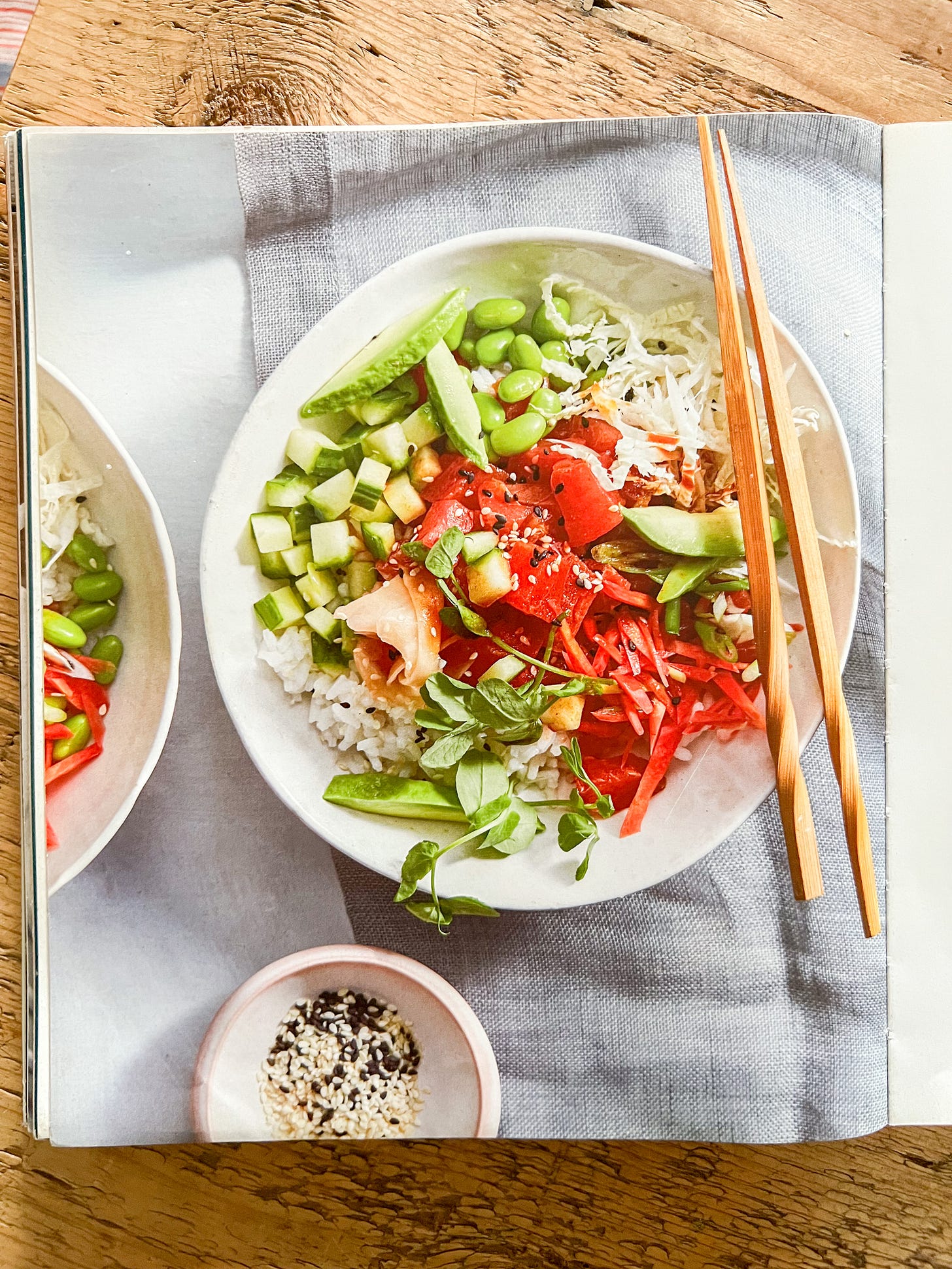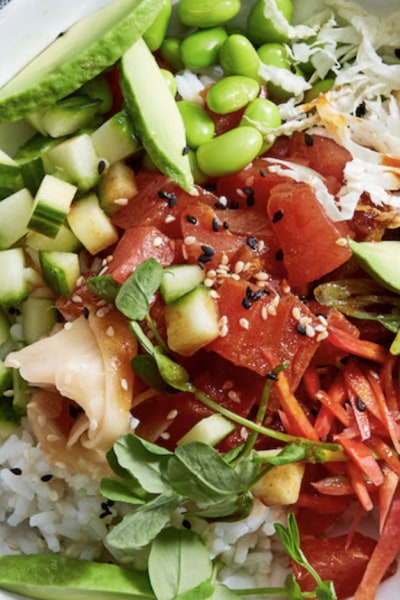I’m headed to Hawaii tomorrow, so it only feels fair to share a bonus recipe with you this week: poke bowls!
This is a recipe from my cookbook, Just Married (but we added all of the WTC style notes and subs!), and it is actually a ridiculously easy meal, despite seeming complex and like something you’d never make at home. All it takes is really great fish and a few simple Asian ingredients, all of which can be found at a normal grocer, and all of which you probably already own if you cook a lot of my recipes!
George and I honeymooned in Kauai and Maui, so poke has a very special place in our hearts. Poke is raw fish diced and tossed with different sauces, traditionally soy sauce-based. After a morning of hiking or surfing, we found our way to a local fish counter almost every day for fresh Hawaiian poke.
sesame soy tuna poke bowls
Serves 2
Cook time: 30 minutes
Tools:
Ingredients:
3 tablespoons soy sauce
1 tablespoon sesame oil
1 tablespoon rice vinegar
2 teaspoons sriracha
1 tablespoon toasted sesame seeds
1 (1-inch) piece peeled fresh ginger, grated
1 garlic clove, grated
1 pound fresh ahi tuna fillet, cut into 1/2-inch cubes
4 scallions, white and green parts, thinly sliced
Suggested toppings:
1 to 2 cups cooked white rice
1 cup shredded napa cabbage
1 avocado, thinly sliced
1/4 cup cooked and shelled edamame
1/4 cup shredded carrot
1/4 cup cubed cucumber
3 tablespoons store-bought pickled ginger
In a large bowl, whisk 3 tablespoons soy sauce, 1 tablespoon sesame oil, 1 tablespoon rice vinegar, 2 teaspoons sriracha, 1 tablespoon toasted sesame seeds, a 1-inch piece of fresh ginger (peeled and grated), and 1 grated garlic clove. Toss in 1 pound cubed fresh ahi tuna, cover, and refrigerate to marinate.
Meanwhile, cook your rice (you’ll want 1 to 2 cups of cooked rice) and prepare the toppings of your choice (1 cup shredded napa cabbage, 1 thinly sliced avocado, 1/2 cup cooked and shelled edamame, 1/4 cup shredded carrot, 1/4 cup cubed cucumber, 3 tablespoons store-bought pickled ginger).
To prepare the bowls, divide the rice, tuna, and desired toppings between two bowls. Enjoy immediately!
link to printer version
Spicy mayo riff: Make a spicy mayo poke instead of — or along with — your sesame soy poke. To do so, stir together 2 tablespoons mayonnaise, 1 tablespoon sriracha, 1 tablespoon sesame oil, and a big pinch of salt and toss. You can marinate the tuna in it, or use it as a sauce to drizzle over your poke bowls.
I’m scared of raw fish: You don’t have to be! But if it freaks you out, marinate the tuna in a light layer of soy sauce, then sear it in a piping hot skillet on each side for a few minutes.
Leftovers are a good thing: It’s best to enjoy your poke right away, but it will keep, stored in an airtight glass container in the refrigerator, for up to 2 days.
Shop smart + save time: If you ask nicely, most fishmongers will cut your tuna into cubes for you. Buy shredded cabbage, shredded carrots, pre-cut cucumber, and cooked rice from the salad and hot bar if you’re really trying to do as little work as possible. You could also use microwaveable frozen rice instead of cooking it from scratch.
Remember coconut rice? If you have the time and ingredients on hand, coconut rice is DELICIOUS here.
Do your thing: I’ve shared my go-to toppings in the recipe, but you can mix it up as much as you want — that’s part of the fun of poke bowls. Some other ideas: Julienned radish, thinly sliced red bell pepper (or any bell pepper) or daikon, cubed mango or pineapple, fried shallot, pickled red onions (maybe you have leftovers from Sunday’s recipe!?), thinly sliced red cabbage, cilantro, thinly sliced basil, macadamia nuts, pistachios… What’d I miss?
Cooking for 4: Double it!
Feeding kids: My children love any meal with a lot of toppings because they can create their own bowl. If yours are sensitive to spice, you can skip sriracha in the marinade and instead top your bowl with it. If you have young kids or are pregnant, you may also want to pay attention to the ahi tuna you buy as one type (Big Eye) can be high in mercury and is considered a “choice to avoid” for babies and young children by the FDA. The other type of ahi tuna, yellowfin, is classified as a “good choice,” and salmon, a sub option, is a “great choice.” Check out this chart for more info!
Vegetarian: Use a block of firm or extra firm tofu in lieu of tuna. Marinate it just like the fish.
Gluten-free: Soy sauce has gluten, so use tamari or coconut aminos instead.
Dairy-free: Already is!
Soy sauce: Tamari or coconut aminos — or see note above for a spicy mayo marinade alternative.
Sesame oil: Another oil (like walnut, grapeseed, or olive oil) or tahini
Rice vinegar: Another vinegar (white wine, red wine, or apple cider)
Sriracha: Sambal oelek, chili garlic sauce, gochujang, or omit
Sesame seeds: Omit if needed
Fresh ginger: Thawed frozen ginger or ginger paste. If you’re in a pinch, 1 teaspoon of ground ginger would work.
Fresh garlic: Thawed frozen garlic, garlic paste, or a 1/8 teaspoon garlic powder
Ahi tuna: Sushi-grade salmon, shrimp (but you will want to pan-sear or steam the shrimp until they’re opaque after marinating), or tofu. If you don’t like seafood or tofu, you could also use chicken or steak. Cube the meat, marinate it in the same marinade, and pan-sear it until cooked to a safe internal temperature (165°F for chicken; 125°-130°F for rare steak — or higher, if you prefer).
Scallions: Pickled onion, chives, cilantro, basil, or another leafy green herb
White rice: Any rice (sushi, basmati, jasmine, brown, etc.) or grain you love works!
Other toppings: See the “do your thing” note above for many alternative ideas. Dumpster dive through your fridge and use whatever you have.
Click here for the full index of What to Cook recipes categorized by protein, cook time, and *mood.*









The Annasea brand also has frozen poke at my local grocery store, for those who don't have a good fish counter near them! I just ditch their sauce half the time. $10/box for 3 servings here and it's delicious!
Wow this looks so good, especially right now with the winter doldrums - just looking at it gave me a smile. Where do people buy fish they will eat raw? If I go to the fish counter at Whole Foods is that OK or do we need to go find where they have sushi grade fish (I don't even know exactly what that means). Thanks!